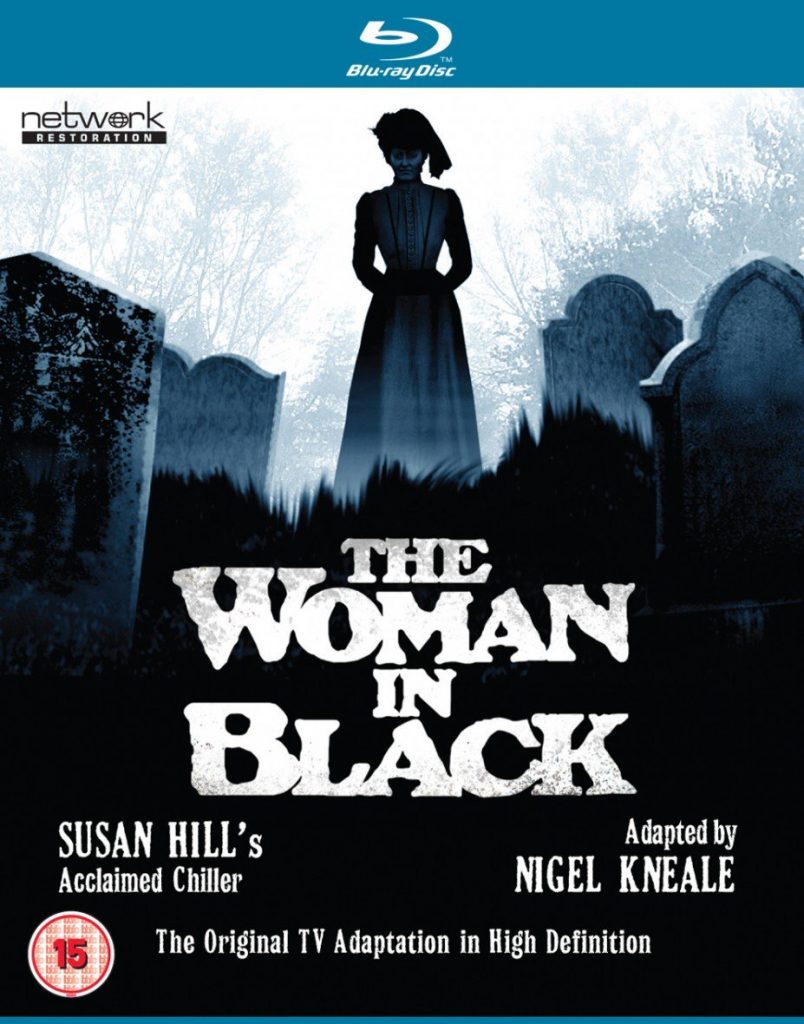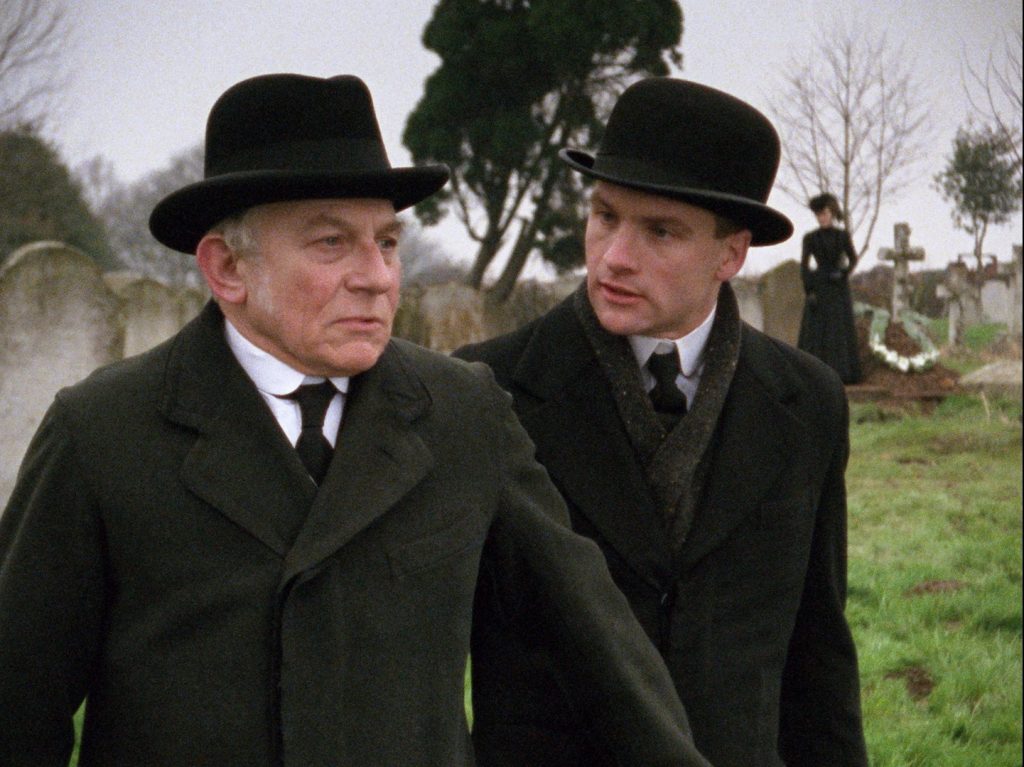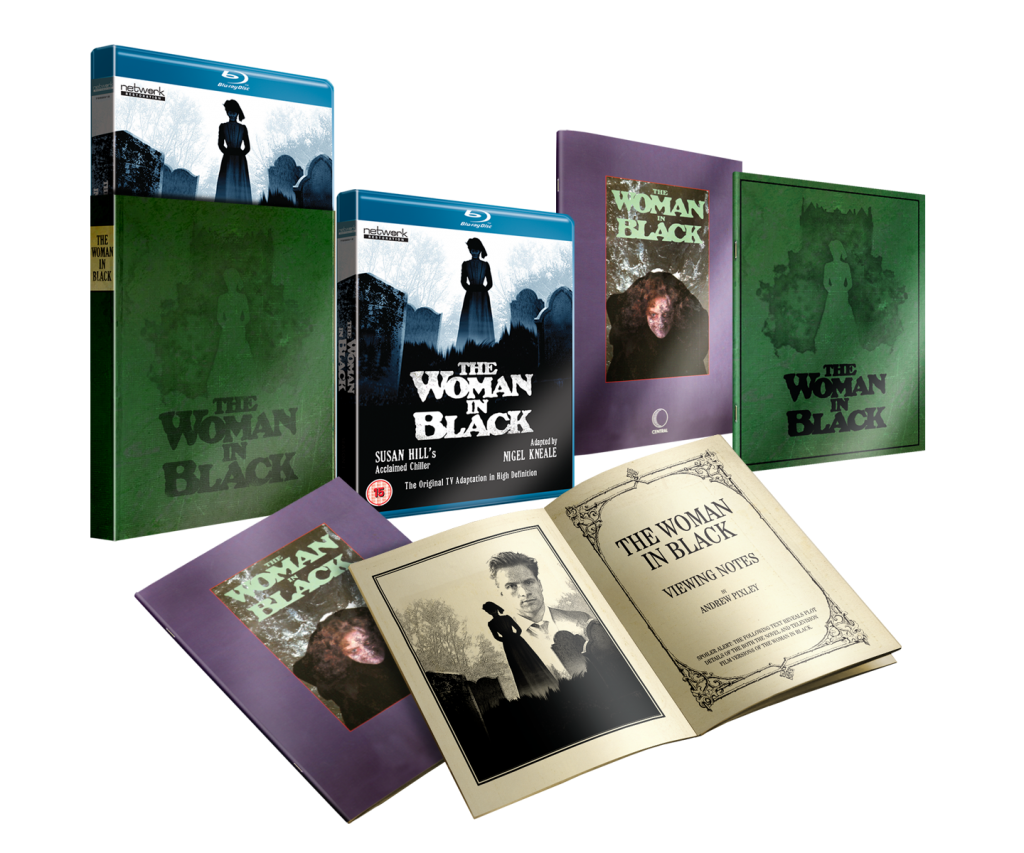The Woman in Black, 1989, Blu-Ray
Network Distribution
Reviewed by Tim Robins

Network Distribution is to be congratulated for its excellent restoration of Central Television’s The Woman in Black (1989), the acclaimed film for television that continues to haunt the imaginations of those who first saw the production when it was broadcast on Christmas Eve 1989.
The Woman in Black is based on Susan Hill’s novel of the same name. Hill’s story is a rather knowing recollection of ghost stories by Charles Dickens, M.R.James and others. Hill mischievously nicked James’ story title “Whistle and I’ll Come to You” for a chapter title in her own story. The scenario also recalls Bram Stoker’s Dracula, among other gothic romances. Hill is so aware of her book’s location within that genre that the novel might justifiably be identified as a work of postmodern pastiche.
The story begins one Christmas when the narrator, a solicitor Mr Kipps (a nod to HG Wells’ titular character) reluctantly recounts a time when he was tasked by his superior to attend the funeral of an elderly client. At the funeral, Kipps catches his sight of a woman mourner, but his attempts to learn her identity from locals are met with palpable terror.

While visiting the deceased’s house, dramatically situated across a treacherous causeway, Kipps experiences disturbing echoes of the past, hints of a family tragedy and a vengeful spirit who menaces the children and parents of the coastal community.
The TV adaptation is the work of director Herbert Wise and script writer Nigel Kneale, who are synonymous quality television. Those of a certain age will remember Wise’s work on BBC 2’s I, Claudius, an adaptation that left HBO’s Game of Thrones feeling a little humdrum for me, not least because I Claudius was about actual historical events. Kneale had cemented his reputation as a writer of the eerie and downright terrifying with his Quatermass tetralogy (1953, 1955 and 1958 for the BBC), Quatermass (Thames Television, 1979) and Beasts (1976), six horror stories based around animals, for ITV.
Hill’s The Woman in Black had already been adapted into a beloved stage-play (1987) that went to become the West End’s second longest running, non-musical after The Moustrap. More recently, the story was filmed by Hammer (2012), an adaptation that some fans found formulaic but which nevertheless went on to be the highest grossing British horror movie of all time. (The film may have been helped by its ending, in which the titular woman in black engages in a slap down with a woman in white).
Compared to the 2012 movie, Kneale’s work is a lot more assured. Even so, the writer makes provocative changes to the original novel. Contacted by The Guardian newspaper in connection with the release of the Blu-ray, Susan Hill noted “There were some arbitrary changes I didn’t like, I thought it was weird to change [some of] the names of characters and even the sex of the dog.” Kneale, who could be notoriously cantankerous at times, particularly dislike Hill’s borrowing of the name of ‘Kipps’ and changed it to Kidd for his adaptation.
Kneale also dispenses with the novel’s opening scenes with Kipps telling his story surrounded by his family at Christmas. This move also allows Kneale to craft his own, bleaker conclusion which owes little to the original.
It’s strange that the ending of Hill’s novel poses so much worry; perhaps it is too obvious for audiences knowledgeable about the conventions of horror or perhaps the suspense of her final chapter is a pleasure only reading can provide.

Despite Hill’s caveats, the adaptation is Kneale on top form considering, as we are told in the commentary, he knocked out the script in two weeks. Kneale makes Kidd (Adrian Rawlins) a kindly man and yet, by the harsh standards of his employer, somewhat weak. Kidd’s softer side is established early on. Much to the disapproval of the law firm’s senior partner, Kidd has a not very profitable client, a soldier suffering from the effects of Mustard Gas, for whom Kidd is seeking an enhanced pension.
On his train journey to the funeral, Kidd offers sweets to a child who is sitting with her mother opposite him. Later, Kidd saves a child from an otherwise fatal accident and thwarts the curse that hangs over the village. Kneale’s skill is revealed in the way such additions serve multiple purposes. Much like Dickens, he dramatises class differences between Kidd and others in Kidd’s life by making the characters subtly emblematic of their place in the social hierarchy of the time.

Herbert Wise’s direction presents a remarkably naturalistic horror, particularly in the way the dialogue is delivered in a conversational style that avoids the camp and histrionic. The location filming capture a nostalgic and familiar British town life and surrounding countryside. Long takes allow audiences to become involved with the characters, enjoy the landscape and, as I did, bathe in the extraordinarily detailed period mise-en-scene helped by the director’s use of a long depth of field that leaves the many wonderfully empirical objects in the foreground and background available for contemplation. This attention to the lived experience of cursed rustic lives mark the story as an example of folk horror, a term used by Mark Gatiss for films such as Blood on Satan’s Claw and The Wicker Man.
As for the woman in black herself, played with suitable menace by Pauline Moran, I seem to be alone in wishing that her make-up resembled Hill’s description of a hideous, skeletal and wasted corpse, and feeling that the presentation of the apparition might have benefited from some more lurid touches. At times, I found myself calling for more fog effects. Nevertheless, The Woman in Black was nominated for four BAFTA awards, including Best Design, Best Film Sound, Best Makeup and Best Original Television Music.

The Blu-Ray comes with an informative booklet by Andrew Pixley and a commentary track provided by Kim Newman, Mark Gatiss and writer, director, actor Andy (Peaky Blinders) Nyman, who is himself a bit of a horror buff. The Woman in Black gave Nyman his first Television role as Jackie, a clerk at the law firm. All three commentators derive epicurean pleasure from a production that is ripe with character actors and, for them, often poignant personal memories.
I am not a fan of commentaries; too often, they are akin sitting in a pub and having to listen to a loud conversation to which one is not invited to be a part, but it wouldn’t be possible to have more informed, enthusiastic and amiable companions to a haunting place and time.
Although the Woman in Black Limited Edition Blu-Ray has, unsurprisingly, sold out, standard editions and a DVD edition are on the way, but there’s no release date yet. However, there’s now a “register interest” option on the website to get a mail back when dates are announced.
Tim Robins
THE WOMAN IN BLACK LIMITED EDITION BLU-RAY – SPECIAL FEATURES
– Feature version in full widescreen
– Limited edition, specially designed o-card packaging
– Audio commentary with horror experts Mark Gatiss, Kim Newman and star Andy Nyman
– Image gallery
– Booklet by Andrew Pixley
TECH SPECS
– 1080p HD
– Aspect ratio: 1.37:1
– Running time: 102 mins
– HOH subtitles
– Certificate: 15
– Region code: B
– Cat: 7958312
– Original Release: 1989
A freelance journalist and Doctor Who fanzine editor since 1978, Tim Robins has written on comics, films, books and TV programmes for a wide range of publications including Starburst, Interzone, Primetime and TV Guide.
His brief flirtation with comics includes ghost inking a 2000AD strip and co-writing a Doctor Who strip with Mike Collins. Since 1990 he worked at the University of Glamorgan where he was a Senior Lecturer in Cultural and Media Studies and the social sciences. Academically, he has published on the animation industry in Wales and approaches to social memory. He claims to be a card carrying member of the Politically Correct, a secret cadre bent on ruling the entire world and all human thought.
Categories: Digital Media, downthetubes News, Features, Other Worlds, Reviews, Television
 In Review: Doctor Who – The Legend of Ruby Sunday/ The Empire of Death
In Review: Doctor Who – The Legend of Ruby Sunday/ The Empire of Death  In Review: The Rings of Power
In Review: The Rings of Power  In Review: Werewolf by Night
In Review: Werewolf by Night  In Review: Ms. Marvel
In Review: Ms. Marvel